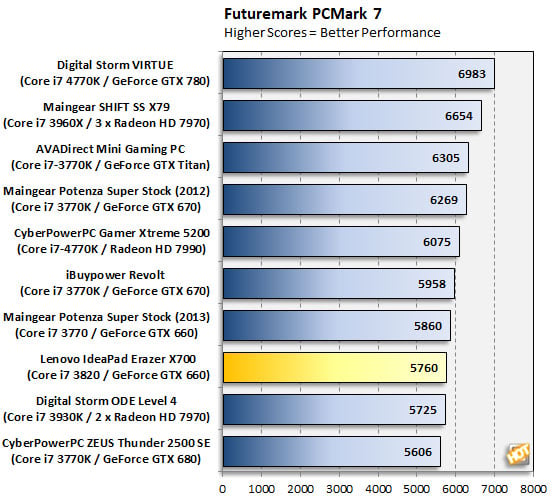To kick things off we fired up Futuremark's system performance benchmark, PCMark 7. This synthetic benchmark suite simulates a range of real-world scenarios and workloads, stressing various system subsets in the process. Everything you'd want to do with your PC -- watching HD movies, music compression, image editing, gaming, and so forth -- is represented here. Also, most of the tests are multi-threaded, making this a good indicator of all-around performance.
From there, we switched gears to 3DMark to get a feel for gaming potential before jumping into our gauntlet of real-world game benchmarks.
 |
Futuremark PCMark 7
|
Simulated Application Performance
|
|

PCMark 7
|
PCMark 7 runs through the types of tasks your PC is likely to encounter during ordinary home and office use. It tests the system’s graphics capabilities as well, but it isn’t mean to test the limits of high-end, discrete graphics card. Look at PCMark 7 as an indicator of a system’s general usage performance. |
The IdeaCentre Erazer X700 edged out a couple of systems in PCMark 7 though was still towards the bottom of the pack. What stands out is that it scored slightly lower than similarly equipped systems, and we have our hunches why. One of them is because the system is only running in triple-channel mode instead of quad-channel mode due to the inclusion of three DDR3 memory sticks instead of four. In addition, the mini-ITX motherboard probably isn't a performance model, nor is anything overclocked on this system. When you put those factors together, it would explain why the Erazer X700 runs a little slower than the competition.
 |
| Futuremark 3DMark 11 |
| Simulated Gaming Performance |
|

3DMark 11
|
Although Futuremark’s 3DMark 11 has been around for several years, it still provides a good look at a system’s gaming capabilities. It's also handy tool for benchmarking machines that still run Windows 7. We ran this benchmark on the Performance preset, at 1280 x 720 resolution. If you download the free version of this benchmark, make sure you're using the Performance preset to avoid comparing scores that were run with different test configurations.
|
The same story played out in 3DMark 11, though at first glance we were surprised the discrepancy between the Erazer X700 and Maingear Potenza was around 1,700 points. A closer look reveals that Maingear's system is running an overclocked MSI GeForce GTX 660 Twin Frozr III graphics card, versus the stock clocked model in Lenovo's rig. Maingear's system also has more RAM, a higher end motherboard, and an Ivy Bridge processor, all of which give it a performance advantage.
 |
| Futuremark 3DMark Fire Strike |
| Simulated Gaming Performance |
|

3DMark Fire Strike
|
The next test we ran was Futuremark’s newest: 3DMark Fire Strike is designed specifically for high-end gaming PCs like the Tiki. Because Extreme mode is geared towards systems that have multiple graphics cards in CrossFire or SLI configurations, we opted for Normal mode, which runs at 1920 x 1080.
|
Futuremark's 3DMark FireStrike tests had Lenovo's rig trailing Maingear by just a few frames per second, which isn't too bad considering the performance advantages mentioned above.

















